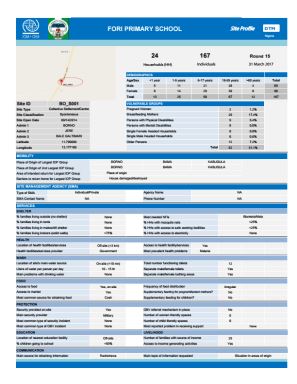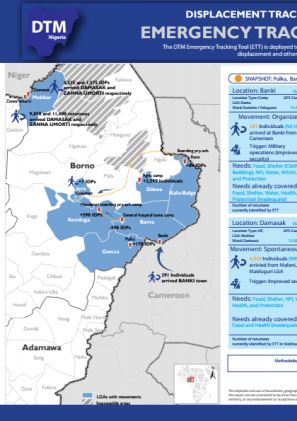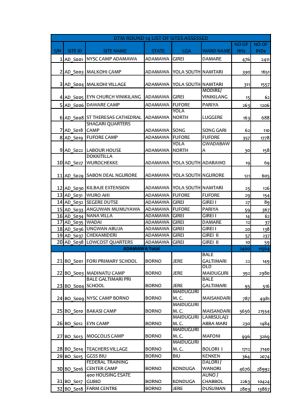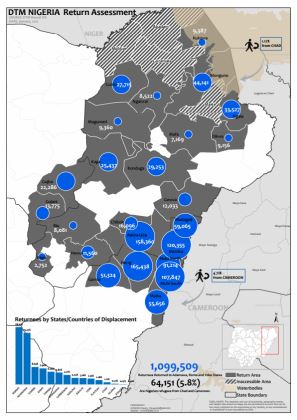-
Countries
-
Data and Analysis
-
Special Focus
-
Crisis Responses
Nigeria
Nigeria
Suivi des PDI
Mouvements de déplacement
3,340,000
IDMC 2023
cycle de collecte de données
À propos Nigeria
The escalation of violence between all parties in north-eastern Nigeria since 2014 has resulted in mass displacement and deprivation in the states of Adamawa, Bauchi, Borno, Gombe, Taraba and Yobe. To better understand the scope of displacement and assess the needs of affected populations, IOM has been implementing its Displacement Tracking Matrix (DTM) programme starting July 2014, in collaboration with the National Emergency Management Agency (NEMA) and State Emergency Management Agencies (SEMAs). The activities of the DTM project, which consist of conducting baseline assessments and registration for IDPs living in camps and host communities, are currently being carried out in Adamawa, Bauchi, Borno, Gombe, Taraba and Yobe.
The information collected will contribute to the provision of a comprehensive profile of the IDP population in Nigeria which will be shared with all relevant stakeholders and will contribute towards enabling the government of Nigeria and humanitarian partners identify the needs of Nigeria's displaced population and develop interventions for providing IDPs necessary assistance.
Contacter
DTM Nigeria
DTMNigeria@iom.int
Bailleurs de fonds
- ECHO
- BHA
- Canada
Nigeria — Borno Site Profiles 15 (March 2017)
This is a compilation of all Round 15 Borno Site profiles.
Mar 31 2017
Nigeria — Borno Site Profiles 15 (March 2017)
Nigeria — Taraba Site Profiles 15 (15—31 March 2017)
This is a compilation of all round 15 Taraba site profiles.
Nigeria — Yobe Site Profiles 15 (15 February — 31 March 2017)
This is a compilation of all Round 15 Yobe site profiles.
Nigeria — Emergency Tracking Tool Report 7 (21—27 March 2017)
DTM emergency tracking was deployed in Nigeria to track and provide up-to-date information on sudden displacement and other population movements in Dikwa, Jere, Kala/Bagle, Ngala, Nganzai and Bama.
Nigeria — Emergency Tracking Tool Report 6 (15—21 March 2017)
This snapshot includes information on numbers, displacement reasons and needs from IDPs in five local government areas (LGAs): Gwoza, Kala Balge, Bama, Ngala and Dikwa. The largest numbers of IDPs are in Kala Balge LGA: there are currently 3,070 IDPs (614 households) due to military operations.
Nigeria — Emergency Tracking Tool Report 5 (10—14 March 2017)
Emergency tracking for: Bama (335 arrivals), Moguno (41 arrivals), Mobbar (1,050 arrivals), Kala/Balge (195 arrivals), Dikwa (911 arrivals).
Nigeria — Emergency Tracking Tool Report 4 (24 February—9 March 2017)
This snapshot includes information on numbers, displacement reasons and needs from IDPs in eight local government areas (LGAs). 3,945 IDPs (734 households) were displaced due to recent attacks in Chibok. The largest numbers are in the main Chibok town (Garu, Likama and Whumtaku wards).
Nigeria — Emergency Tracking Tool Report 3 (18—26 Februrary 2017)
A snapshot of the movement of people from: Barna (246 arrivals), Dikwa (234 arrivals), Kala/Balge (320 arrivals), Mobbar, Kodunga, Gwoza (892 arrivals), Monguno (54 arrivals), Kukawa (370 arrivals), Yola South (42 arrivals) and Mub (60 arrivals).
Nigeria — Biometric Registration Report Northeastern Nigeria (13—19 February 2017)
IOM's biometric registration project is currently being implemented in three states in northeastern Nigeria. In total, 340,734 individuals have been registered in Borno, 143,496 in Adamawa and 21,201 in Yobe.
Nigeria — Emergency Tracking Tool Report 2 (13—19 February 2017)
This snapshot provides information on location, movement and needs of displacement in Pulka, Bama, Dikwa, Kala/Balge, Mobbar,Konduga and Gwoza during the covered period.
Nigeria — Returnee Dashboard 14 (19 December 2016 — 25 January 2017)
This dashboard is a map indicating the number of returnees per LGA. 1,099,509 returnees returned to Adamawa, Borno and Yobe States. 64,151 (5.8%) were Nigerian refugees from Chad and Cameroon. The map indicates return areas, inaccessible areas, water boundaries and state boundaries.
Nigeria — Yobe Site Profiles 14 (19 December 2016—25 January 2017)
A collection of 5 individual Site Profiles. Site Profiles provide information about demographics, vulnerable groups, mobility, site management and services (Shelter, Health, Wash, Food, and Protection).
Nigeria — Taraba Site Profiles 14 (19 December 2016—25 January 2017)
A collection of 12 individual Site Profiles. Site Profiles provide information about demographics, vulnerable groups, mobility, site management and services (Shelter, Health, Wash, Food, and Protection).
Nigeria — Adamawa Site Profiles 14 (19 December 2016—25 January 2017)
A collection of 20 individual Site Profiles. Site Profiles provide information about demographics, vulnerable groups, mobility, site management and services (Shelter, Health, Wash, Food, and Protection).
Nigeria — Displacement Dashboard 14 (January 2017)
As of January 25, 2017, DTM has identified 1,899,830 IDPs (337,353 households) across Adamawa, Bauchi, Borno, Gombe, Taraba, and Yobe states.
Nigeria — Displacement Report 14 (January 2017)
Between December 2016 and January 2017, the number of identified IDPs increased by 129,386 individuals (7.3% increase). This brought the total number if IDPs in Nigeria to 1,899,830 (337,353 households).
Feb 14 2017
Nigeria — Displacement Report 14 (January 2017)
Nigeria — Emergency Tracking Tool Report 1 (27 January — 10 February 2017)
The DTM Emergency Tracking System (ETS) was deployed to track and provide up-to-date information on sudden displacement and return movements. The report provides information about the type and trigger of the population movements as well as estimated number of people.
Nigeria — Yobe Site Profiles 14 (19 December 2016—25 January 2017)
This document contains the site profiles for all displacement sites identified in Yobe state, Nigeria.
Nigeria — Taraba State Site Profiles 14 (20 December 2016—25 January 2017)
This document contains the site profiles for all displacement sites identified in Taraba state, Nigeria.
Nigeria — Borno Site Profiles 14 (19 December 2016—25 January 2017)
This document contains the site profiles for all displacement sites identified in Borno state, Nigeria.
Nigeria — List of Wards Assessed 14 (19 December 2016—25 January 2017)
This document lists all the wards assessed in DTM Round 14 by state and Local Government Area, showing the total number of displaced individuals and households identified.
Nigeria — List of Displacement Sites Assessed 14 (19 December 2016—25 January 2017)
This document lists all the sites assessed in DTM Round 14 including the site ID, site name, state, Local Government Area, ward name, number of households and number of individuals.
Nigeria — Returnee Dashboard 14 (19 December 2016—25 January 2017)
1,099,509 returnees to Adamawa, Borno and Yobe states were identified. 64,151 (5.8%) are Nigerian refugees from Chad and Cameroon.
Nigeria — Location Based Assessment Report 13 (1 July 2014—31 December 2016)
As of 31 December, the conflict in the northeastern part of Nigeria has left an estimated 1,770,444 people displaced across the 6 most affected states.
Pagination
Pagination
- First page
- Previous page
- 1
- 2
- 3
- 4
- 5
- 6
- 7
- 8
Pagination
- First page
- Previous page
- 1
- 2
- 3
- 4
- 5
- 6
- 7


























